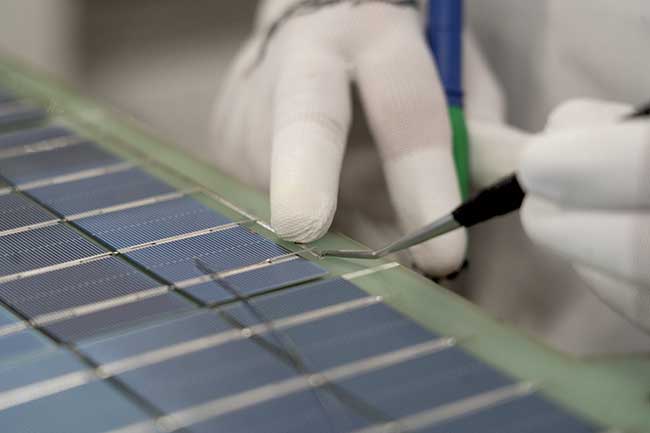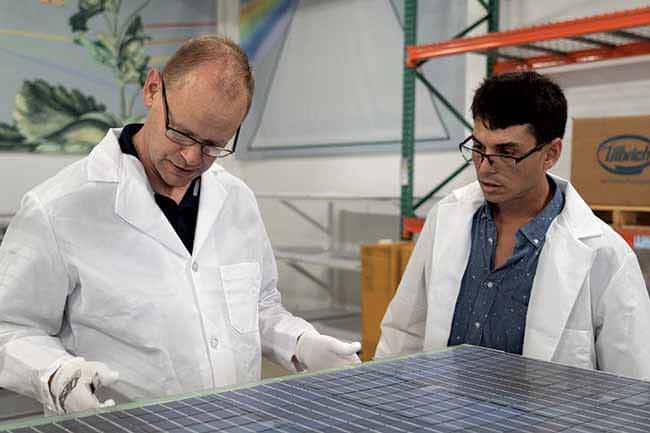CHERP’s big ambitions move closer to fruition

by Mick Rhodes | editor@claremont-courier.com
After nearly eight years of consciousness raising, coalition building, pandemic-related delays, and a complete revamp of its initial product, Claremont’s remarkably ambitious CHERP Solar Works began making solar panels at its Pomona facility on September 14.
The nonprofit has its eye on the lofty goal of revitalizing economically disadvantaged communities through the creation of thousands of manufacturing and field jobs at solar panel factories across the country.
“We’ve always had very, very ambitious and scalable goals,” said CHERP President and CEO Devon Hartman. “We knew in the beginning this was going to get very big.”
The project checks many of the boxes American culture has come to care about over the last decade, Hartman said, including global warming, renewable energy, local jobs, stimulating local economies, environmental justice and equity.
It’s a big idea, and Hartman remains evangelical in his belief it will work.
“This is really a play to demonstrate that deployment of world class, cutting edge technology can be done in a manner that advantages our most disadvantaged communities, or our most underserved communities,” Hartman told the COURIER.
While CHERP’s ambitions are enormous, nationwide, it also aims to have a local impact. All will be discussed from 1 to 3 p.m. Saturday, October 1, when it hosts the quarterly meeting of more than 70 chief sustainability officers from around L.A. County, including representatives from UCLA, CalTech, Disney, the City of Santa Monica, at its Pomona factory. The public is invited to watch and listen over Zoom. Pre-registration is required. To get the link, contact CHERP at cherplgp.org/contact.
At the moment, CHERP is waiting on ETL certification of its recently revamped solar panel design. The ETL mark denotes compliance to the requirements of widely accepted product safety standards. Following that certification, which is expected in the fall, manufacturing will begin in earnest, Hartman said.

CHERP Solar Works Director of Manufacturing Jason Flejter, left, speaks with senior design engineer Ronald Crisp earlier this month as they prepare to move a large solar panel onto a machine for testing. COURIER photo/Andrew Alonzo
From the beginning, naysayers contended a U.S. company could not manufacture solar panels due to the higher costs — when compared to Asia — of labor, importing parts and computer chips, Hartman said, adding 94% of U.S. panels are imported from the Far East.
Hartman says CHERP is poised to prove them wrong.
“We will be competitive with Asia with our panels,” he said, “number one because of the technology, and number two, because of the nonprofit business model in which we’re deploying it across the country.”
Los Angeles County has a goal of distributing 10 new gigawatts — equal to the output of roughly 30 million solar panels — of renewable energy resources by 2045. Based on today’s market, that would mean sending $5 billion to Asia to purchase the panels.
CHERP aims to set up manufacturing factories throughout L.A. County so that $5 billion stays here, as would the more than 10,000 good paying jobs it would generate, all in the most disadvantaged communities in the county, Hartman said.
The nonprofit has been working from the get-go to convince the powers that be and purse-string holders that it can compete with Asian manufacturers, and had been making significant headway prior to March 2020. But when assembly lines around the world suddenly fell silent as Covid spread, the computer chips so vital to CHERP’s solar panel technology became unavailable.
Things looked bleak, as CHERP’s software had been designed around the unobtainable chips. The workaround? Upgrade their panels with the latest, fastest chips on the market, which just so happened to be available.
But it involved investing in a team of engineers, mathematicians and coders to rewrite the panel software to interface with the newer, faster, and more powerful chips. The estimate at the time was it would take three months. It took 18.
“We wish we would not have had to do it at that time, but we just had to bite the bullet because of availability worldwide,” Hartman said.
He declined to say just how expensive that bullet was, but Hartman did report CHERP has thus far spent close to $4 million on getting the Pomona factory up and running.
The end result of the recent panel upgrade was a much more efficient, flexible, and safe solar panel, Hartman said, and six more CHERP patents in the queue with the United States Patent and Trademark Office. The nonprofit has already won two patents for its solar panel technology.
Hartman says he hopes for ETL approval by January 2023, at which time CHERP will begin manufacturing at its Pomona factory.
Hartman said the CHIPS and Science Act of 2022, a $280 billion spending package designed to revitalize domestic computer chip manufacturing that President Biden recently signed into law, is a good step.
“And of course that’s exactly what we are about: we want to bring back middle class manufacturing, but specifically right now around renewable energy, to the United States,” Hartman said. “Because it’s just simply unacceptable that, as we discovered three years ago, we couldn’t even make a paper mask in this country,” Hartman said. “We need to get very serious about rethinking the whole economic equation where we’re betting everything to be able to buy a cheap product from Asia, but nobody here is working.
“If you don’t have a job it doesn’t matter how cheap the product is, you still can’t afford to buy it.”
Part of CHERP’s October 1 meeting will be dedicated to launching its “Factories for the Future” initiative to begin the process of identifying future factory locations in each of the five L.A. County Supervisors’ districts.
It has also created a national board of advisors, cheekily named “The Solar Justice League.” The organization it tapped with exploring the avenues for taking CHERP’s Pomona prototype nationwide.
“This next phase, starting this fall, will be starting to go from prototype to replication,” Hartman said.
One of CHERP’s primary goals has been to make the safest solar panel in the world, Hartman said. The nonprofit is awaiting patents in the areas of rapid shutdown, detection of humans in the circuitry, and suppression of plasma arcs.
“And all of this happens at sub thousands of a second in our panels, and it comes right inside the computer chip, inside our software,” Hartman said.
To get an idea of the safety concerns CHERP aims to mitigate, Hartman recommended readers Google, “Amazon takes solar panels off warehouses.”
CHERP’s new panels all contain computers, which makes them actual “software defined, fully upgradable solar modules,” Hartman said. “It’s an electronic appliance.”
Each is regulated to shut down automatically before creating a spark or plasma arc.
“Suffice it to say that it’s a very big deal to the insurance industry that these panels are much, much safer.”
Many of the upgrades have also meant CHERP’s new panels last much longer and produce much more energy than any previous iteration on market, Hartman said.
It would seem the time is ripe for the CHERP model to thrive, with heightened need in the areas of jobs, renewable energy deployment, and economic justice issues.
“These issues are urgent, and we feel that urgency. We’re excited to go as big as we possibly can as fast as we can,” Hartman said.
More info is at cherplgp.org.









0 Comments